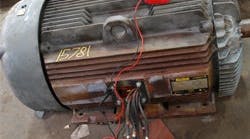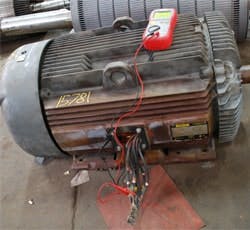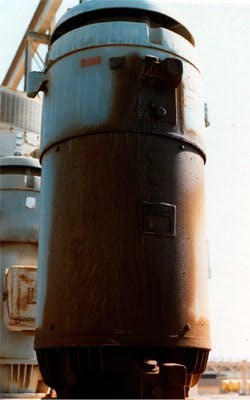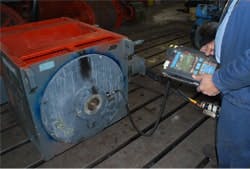We often hear the terms preventive maintenance (PM) and predictive maintenance (PdM) of electric motors, but far less often do we give consideration to the tasks associated with these methods of maintaining motor operation and extending operating service life. This article addresses some of the more common activities associated with PM and PdM, with the focus on three-phase squirrel cage motors.
Preventive maintenance activities
Preventive maintenance primarily consists of face value “snap-shot” assessments of motor health taken at planned and fixed intervals, and then making judgments on machinery condition usually based only on a single set of readings and observations. That is, a test or inspection is performed and evaluated based solely on its outcome.
If the assessment is obvious or easily compared to acceptance parameters, the action to be taken, if any, is clear. For example, an insulation resistance (IR) test is regularly performed on a winding using a megohmmeter, and the winding condition is assessed based on the megohm value obtained in the test; a stator winding insulation resistance value of zero megohms indicates a probable need to rewind the motor.
Electrical tests commonly used in a preventive maintenance program include insulation resistance, polarization index (PI) and measurement of the current and voltages of each phase. Less common electrical tests include measuring motor electrical circuit parameters (i.e., resistance, inductance, and capacitance), and motor current signature analysis (MCSA).
The insulation resistance (IR) test (see Figure 1) is an offline test that is typically performed using a megohmmeter. The test is applied between winding and the frame (ground) for 1 minute at a voltage level in accordance with ANSI/EASAAR100. If the phases of the winding can be isolated, such as with a wye-delta connection, each phase should be tested separately. AR100, and the source standard for insulation resistance testing (IEEE 43) define minimum acceptable IR values.
The polarization index (PI) test is an extension of the offline IR test. The IR test voltage remains applied for 10 minutes, and the ratio of the 10 minute to 1 minute insulation resistance is obtained. This ratio is termed the polarization index, and is a useful test for form coil AC windings. For random windings, which have a different insulation resistance versus time characteristic, the PI result is rarely, if ever, meaningful; thus the IR test value should be used to assess random winding ground insulation. An advantage of the PI versus IR test is that the PI test assessment is not affected by winding temperature as long as the winding temperature does not change during the 10 minute test period.
The less common motor circuit electrical parameter tests require more sophisticated test equipment than the megohmmeter. A digital low-resistance ohmmeter (DLRO) is typically needed to measure winding resistance. Likewise, specialized test equipment is needed for inductance and capacitance measurements. Resistance tests of pairs of three phase winding leads can determine high-resistance connections, and possibly winding misconnections. The measurements of inductance and capacitance between pairs of winding leads can be compared to confirm balance.
Motor current signature analysis (MCSA) detects rotor currents induced into the stator windings. A current transformer on the motor line provides a current signal that is displayed by a spectrum analyzer. Rotor cage faults usually produce sidebands associated with the pole pass frequency. Because slip is required for this test to be useful, it is generally accepted that the motor should be operating at greater than half of rated load. Cracks in rotor bars can create sidebands of frequencies that are multiples of the operating speed. Open or loose rotor bars have been known to cause line frequency sidebands around rotor bar pass frequency, and multiples of rotor bar pass frequency. The rotor bar pass frequency is equal to the number of rotor bars times the operating speed.
Mechanical PM activities include lubrication, lubricant level checks, and lubricant analysis. Grease lubricated bearings require periodic relubrication via grease fittings, making certain that the relief plug is left open long enough for older grease to be purged from the lubricant chamber.
Visual inspection is another important mechanical activity. The motor should be inspected for missing, broken, or damaged parts; indication of lubricant leakage (see Figure 2), and for evidence of contaminants and blockages of the airflow paths. During PM or PdM services minor adjustments can be made, such as to belt tension or loose bolts; and dirt or contaminant accumulation removed from accessible locations. Thermal scanning using an infrared thermometer or camera can be used to check for over-temperature, or increasing temperature conditions. Similarly, ultrasonic testing can be used to detect bearing condition and adequacy of the lubricant fill.
Other activities associated with PM are adjustments such as cleaning, belt tension, and bolt tightness checks. PM judgments are then made based on the results of each activity.
Predictive maintenance activities
Predictive maintenance includes estimating the length of time before a failure might be expected, or before corrective maintenance (corrective action) should be performed. The advantage of PdM over PM is that predictive maintenance makes use of trends in tests or assessments, and from those results a projection of time to failure or time before corrective action is needed can be made.
Predictive maintenance consists of trending and assessing most of the activities associated with PM. Typically these include the electrical IR and PI tests; and occasionally the motor electrical circuit parameters, the current and the voltage levels, and the MCSA results. For example, by trending the winding insulation resistance values, insulation deterioration may be detected and corrective action taken by cleaning and rebuilding a motor without having to rewind it. The trend can also be used to plan a time period for corrective maintenance prior to the IR value becoming unacceptably low.
The most common mechanical test technique for PdM is vibration analysis using a Fast-Fourier Transform (FFT) spectrum analyzer (see Figure 3). These analyzers digitize the vibration signals, calculate the FFT which provides the frequency and amplitude of the vibration, and store the data for trending. Vibration waveform and FFT data can usually be displayed on the analyzer and with related computer software. The data are compared and trended to determine relative machine condition.
Alignment of direct coupled motors is best checked using laser alignment equipment. It requires less downtime than traditional dial indicator alignment, and consequently the values obtained are closer to the operating “hot” aligned condition. A significant drawback to checking alignment is that it requires some downtime; and additional mechanical work such as to remove coupling guards. The benefit is that alignment can be improved, which will increase bearing life of both motor and driven equipment.
Belt alignment can also be checked using laser equipment, or with more traditional straight-edge or string methods. In many cases vibration analysis can be used to detect misalignment, whether direct coupled or belt driven, circumventing the need to periodically check alignment.
Oil lubricated bearings should have the oil tested using lubricant analysis equipment or a lubricant analysis laboratory. The oil sample should be taken with the motor offline, to avoid the possibility of removing an excess amount of oil and operating the bearings with insufficient lubricant.
Testing beyond PM and PdM
Some activities that are not typically part of a PM or PdM program are high potential testing, surge testing and measuring partial discharges (PD). The reason for not including high potential testing and surge testing is that these tests apply an above rated voltage (an over-potential) to the windings. The higher than normal level of electrical stress could result in a winding fault, and downtime. Unless the customer requests these tests, it is good practice not to apply over-potential tests as part of a PM or PdM program.
Partial discharge (PD) testing can be an effective tool for measuring PD activity levels; and can be performed with the motor online or offline. However, it is a sophisticated technology requiring a great deal of expertise to properly assess and interpret the short and long term effects of the measured PD levels. Candidate motors for this type of test are those that are subject to PD, such as motors rated over 5kv or those supplied by VFDs.




